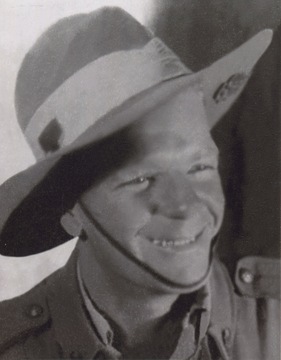
GRIMWOOD, Dennis
| Service Number: | WX20056 |
|---|---|
| Enlisted: | 17 September 1941 |
| Last Rank: | Private |
| Last Unit: | 2nd/28th Infantry Battalion |
| Born: | Cardiff Wales United Kingdom, 1 May 1910 |
| Home Town: | Westonia, Westonia, Western Australia |
| Schooling: | Cardiff Primary School, Wales United Kingdom |
| Occupation: | Labourer |
| Died: | Killed in Action, New Guinea, 9 September 1943, aged 33 years |
| Cemetery: |
No known grave - "Known Unto God" Lae Memorial, Lae, Morobe Province, Papua New Guinea |
| Memorials: | Australian War Memorial Roll of Honour, Kings Park Western Australia State War Memorial, Lae Memorial, Westonia WW2 Roll of Honour |
World War 2 Service
| 3 Sep 1939: | Involvement Private, WX20056 | |
|---|---|---|
| 17 Sep 1941: | Enlisted Australian Military Forces (WW2) , Private, WX20056, 2nd/28th Infantry Battalion | |
| 28 Nov 1941: | Transferred Australian Military Forces (WW2) , Private, 2nd/16th Infantry Battalion | |
| 12 Aug 1942: | Transferred Australian Military Forces (WW2) , Private, 2nd/28th Infantry Battalion | |
| 8 Sep 1942: | Embarked Australian Military Forces (WW2) , Private, WX20056, 2nd/28th Infantry Battalion, Embarked on Convoy U.S 16. | |
| 24 Jan 1943: | Embarked Australian Military Forces (WW2) , Private, WX20056, 2nd/28th Infantry Battalion, Embarked in the Middle East. | |
| 4 Aug 1943: | Embarked Australian Military Forces (WW2) , Private, WX20056, 2nd/28th Infantry Battalion, Embarked Cairns for Milne Bay. |
Help us honour Dennis Grimwood's service by contributing information, stories, and images so that they can be preserved for future generations.
Add my storyBiography contributed by John Baker
History – Private Dennis Grimwood, 2/28th Battalion
Dennis Grimwood was born on 1 May 1910 in Cardiff, Wales. He was the son of Charles Thomas Grimwood and Catherine Morrison Grimwood (formerly Lindsay). His father had been a marine engineer in the Merchant Navy.
Dennis migrated to Australia in 1926 at the age of 16, arriving in Sydney and initially living with his Aunt Minnie in Melbourne. “Denny,” as he was known, found work as a miner in Ballarat. He later moved to Westonia in Western Australia, where he worked at the Edna May Gold Mine.
It was there that he met Phyllis May Moodie. They were married on 7 October 1937 and had two children: Charles Lindsay and Gloria Jean. Charles was two years old, and Gloria was just two months old when their father enlisted in the Second AIF on 17 September 1941.
After a period of leave in early November 1941, he began training and, towards the end of the month, was transferred to the reinforcements for the 2/16th Battalion. In January 1942, he was posted to the “Rottnest Detail.” After war broke out in 1939, Wadjemup (Rottnest Island) was declared a prohibited area in June 1940. All recreational activity ceased. Although initially intended to last only three months, the declaration remained in place for five years, until June 1945. During this period, the island was occupied solely by military and naval personnel, with its two-gun batteries manned 24 hours a day.
In August 1942, Private Grimwood was transferred to the 2/28th Battalion, and in September he embarked with reinforcements for service in the Middle East.
Private Grimwood saw action during the general Allied offensive at Alamein, which lasted from 23 October to 4 November 1942.
Alamein was a significant, though bloody, victory for the Allies. By 6 November, Axis forces were in retreat. However, the 9th Division was soon required elsewhere. The 2/28th Battalion left Alamein in December and moved to Gaza in Palestine to participate in the 9th Division parade on 22 December. In January 1943, the battalion departed Palestine for the Suez Canal, from where it sailed back to Fremantle, arriving on 18 February.
Reorganised for jungle operations, the 2/28th participated in the 9th Division’s amphibious landing at Red Beach, north-west of Lae, in early September.
By 8 September, the commander of the Japanese 51st Division had ordered his forces, including those in Lae, to begin withdrawing.
The 2/28th Infantry Battalion attempted to run a cable across the Busu River, which had become flooded and dangerous after three days of heavy rain. The first soldier to attempt the crossing was killed on the opposite bank by a squad of Japanese. Focus then shifted to the mouth of the river, where a small central island could offer some cover. Covered by mortars and heavy machine-guns, the men fixed bayonets and advanced in company lots, strung out in extended lines. The Japanese opened fire with their own mortars and machine-guns from well-concealed positions on the far bank. Thirteen Australians were killed during the crossing, and dozens more were swept away and had to be rescued by troops from neighbouring units.
Nevertheless, the 2/28th pushed through and succeeded in securing a beachhead on the opposite bank.
The following day, Private Dennis Grimwood was posted as missing in action, believed killed. He was eventually confirmed as having been killed in action on 9 September 1943.
He was 33 years old.
In letters written by fellow soldiers to Dennis’s wife, they spoke of his courage in attempting to cross the fast-flowing river with a full pack, even though he could not swim.
With no known grave, today his name appears on the Lae Memorial, which commemorates over 300 men who lost their lives in operations in the area.
His name is also listed on the Roll of Honour to my left, among almost 40,000 Australians who died while serving in the Second World War.
Dennis’s daughter, Gloria Jean Grimwood (now Curtis), enlisted in the early 1960s with the Women’s Royal Australian Army Corps. One of Dennis’s great-grandsons is now a pilot in the Royal Australian Air Force.
























